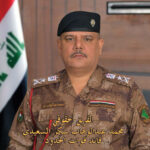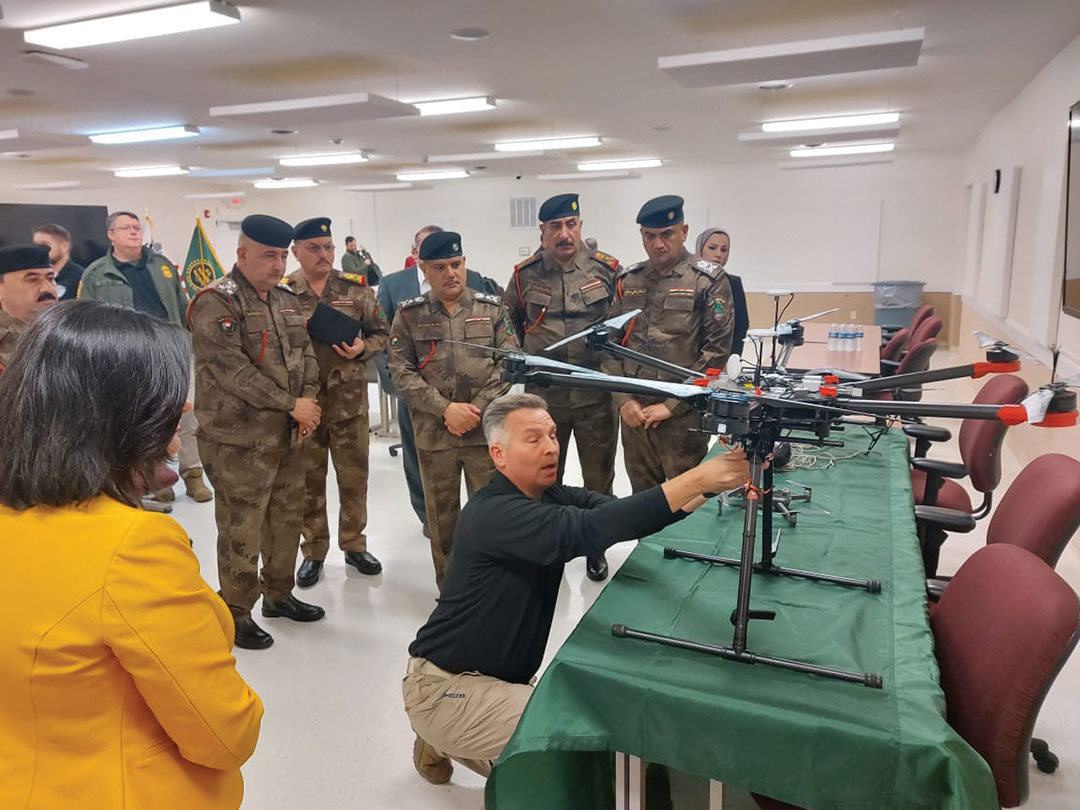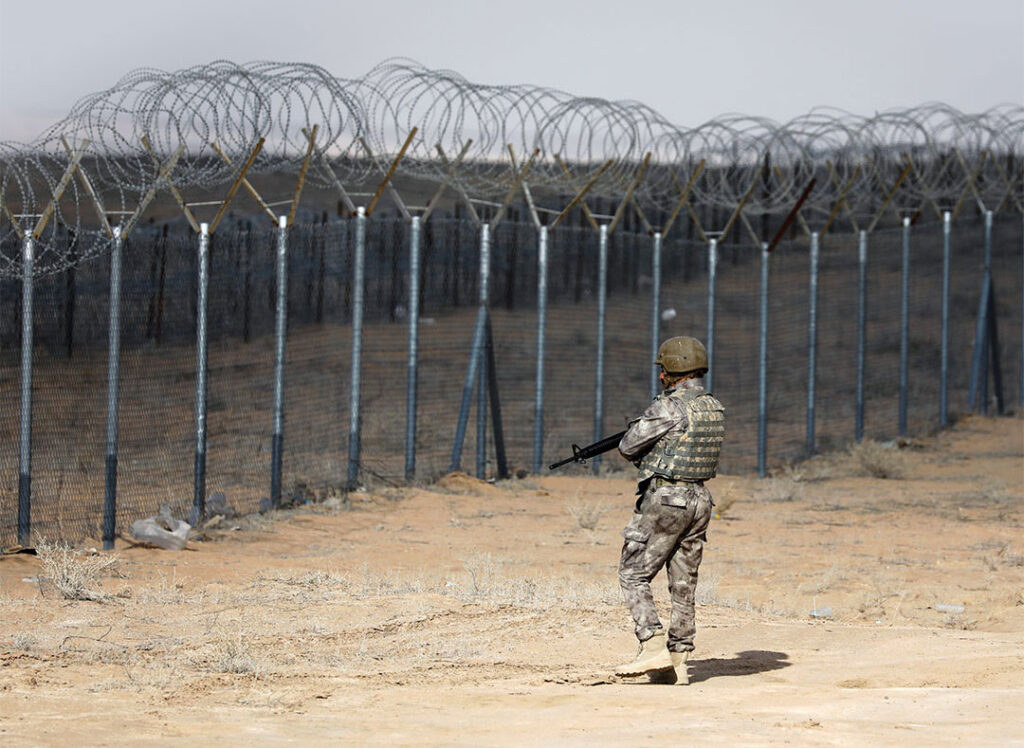The Iraqi Border Guard Command Modernizes Methods To Stop Terrorists And Smugglers
 After Daesh’s military defeat in Iraq and the drying up of its sources of funding, terrorist groups have turned to self-financing by manufacturing and smuggling narcotics. The region has witnessed an unprecedented increase in drug abuse and trafficking, adding to concerns and making border control a matter of urgency for security services. Iraq has completed important projects to control its borders with Syria, a conduit through which Daesh terrorist groups conducted their 2014 invasion of Iraq. Unipath met with Lt. Gen. Muhammad Sukkar Al-Saidi, commander of the Iraqi Border Guards, to talk about border security and ways to prevent infiltration and smuggling.
After Daesh’s military defeat in Iraq and the drying up of its sources of funding, terrorist groups have turned to self-financing by manufacturing and smuggling narcotics. The region has witnessed an unprecedented increase in drug abuse and trafficking, adding to concerns and making border control a matter of urgency for security services. Iraq has completed important projects to control its borders with Syria, a conduit through which Daesh terrorist groups conducted their 2014 invasion of Iraq. Unipath met with Lt. Gen. Muhammad Sukkar Al-Saidi, commander of the Iraqi Border Guards, to talk about border security and ways to prevent infiltration and smuggling.
Unipath: As commander of the Border Guards, how have you approached border security?
Lt. Gen. Al-Saidi: We have significant plans for controlling the borders with neighboring countries that leverage the technologies used by most nations around the world as well as a smart border system that uses cameras, drones and sensors to reduce the manpower burden and ensure accurate border control with neighboring countries. The second aspect is to complete the fortifications of the security fence, which has already proven its effectiveness, together with the concrete wall and trenches. The third aspect relates to roads. These three features are common to all borders. The important thing for us is to focus on controlling the Iraqi-Syrian border, which is the primary threat to the country, to be followed by completion of securing the Iraqi-Iranian border, since that is the source of infiltration of drugs and people.
Unipath: What security threats does the Iraqi Border Guards face?
Lt. Gen. Al-Saidi: The Iraqi-Syrian border north of the Euphrates River, from Al-Qaim to Rabia, is the first axis of threat to the security of the Iraqi border for several reasons, the most important of which is the lack of a functioning state on the Syrian side of the border to control the border strip from its side. What does exist are the Syrian Democratic Forces, but they are unable to assume responsibility for controlling the border strip. This area is approximately 340 km long. Iraqi governorates facing the border are witnessing a lack of security and stability and the free movement of Daesh terrorists there, in addition to the presence of camps for Daesh families and existing prisons, as well as the spillover from deteriorating economic conditions in Syria and Syrians seeking refuge in Iraq. All of these points make this region the primary point of interest for us.
Unipath: How does the Al-Hawl refugee camp relate to border security with Syria?
Lt. Gen. Al-Saidi: Al-Hawl and the other camps are about 7 to 8 km from the Iraqi border. This is very close given the absence of any strong authority in Syria. A significant portion of the residents of Al-Hawl are Iraqis. The rest are of various nationalities, and, according to intelligence, families of Daesh and individuals harboring extremist ideologies. It is therefore a school for extremists and radicals who have the will to leave the camp and reach the border if the security situation inside the camp becomes unstable. It is tightly controlled now, but there are cases of infiltration from the camp from the Syrian side. Bearing in mind that we’ve taken significant steps to control the border, the border control rate is more than 95%; the presence of radicals with these kinds of ideologies has produced a generation of extremists inside the camps that represents a security threat not only to Iraq but also to the region. It is therefore the responsibility of the international community to dismantle these camps and reintegrate the refugees into society. Countries should accept repatriation of their citizens, particularly as Iraq has already transferred large numbers of its own citizens to the Al-Jadaa camp in Mosul.

Unipath Staff
Unipath: What technologies does Iraq hope to receive to secure the border?
Lt. Gen. Al-Saidi: We seek advanced technology like that found in other regional countries like Saudi Arabia and Jordan. This includes advanced infrared cameras, radars for long-range detection and technology for detecting ground targets. The first technology is specific to detecting people, cars and moving objects, even animals. There are radars that accurately contend with ground targets, hold and direct cameras, and reduce human labor. So we need cameras, then radars, followed by drones and sensors. Many regions and countries have smart borders and sensors that detect movement, but our first priority is to cover our borders with advanced cameras. Drones provide security over a distance, exposing a wide area of the border in depth and breadth.
Unipath: Does Border Guard Command operate the drones or is that task assigned to Army Aviation or the Air Force?
Lt. Gen. Al-Saidi: We are talking about small drones covering simple distances of at most 25-30 km. This is part of the Border Guard Command. We have information technology, we have a drones division, and we have the drones themselves, but they have a limited range of between 5 to 6 kilometers. We do, however, need drones with a larger range and longer flight times so it is possible to secure the border in depth, carry out reconnaissance missions, and capture and monitor targets on the Syrian side of the border or along the border strip between distant border posts.
Unipath: How close are you from obtaining these technologies?
Lt. Gen. Al-Saidi: There are significant efforts from the Iraqi state and from the prime minister and the minister of interior to support Border Guard Command to complete the requirements of maintaining the Iraqi border and to secure these requirements. I am certain that what we have seen in the last year in terms of fortification projects has no precedent in the history of the Iraqi state. We have made significant efforts and undertaken important projects for the first time on the borders, especially the Iraqi-Syrian border. We are working hard and have covered the Iraqi-Syrian border with an ideal system of barriers, approximately 340 km long, containing a 3 meters wide by 3 meters deep trench, and a 3 meter high earthen berm, followed by a series of barbed wire fences. Every 1,000 to 1,500 meters are fortified points and concrete towers. Thermal cameras were installed along the Syrian border strip, one after the other, covering the entire border. The current project of importance is to erect a concrete wall on the Iraqi-Syrian border. This wall is an ideal barrier to prevent infiltration and smuggling and to fortify the defensive position that we will have after more than 140 km is completed along the Iraqi-Syrian border. I would also like to mention another important point. Border Guard Command operates a ready-made concrete factory that makes barrier walls, and work is continuing on the border strip from Mount Sinjar towards Rabia. This is the fortification system that we built on the Syrian border. This is the same system that we are building on the Iranian side. We’ve installed thermal cameras from the Ras al-Bisha area in Basra to the Sulaymaniyah Governorate and covered this entire area with overlapping cameras. We also have concrete towers throughout the region. We’ve also begun building police stations and annexes for the Iraqi border. They can be divided in three sections: the first is our border with Turkey and Iran. Iraq has initiated contracts with companies to build these 240 police installations along the entire Iraqi border with all neighboring countries. This is a great achievement. Regarding our border with Iran, we have two projects in Maysan Governorate with a length of 200 km, the first of which is a barbed wire security fence, and the other a PRC fence, that have reached advanced stages of completion. We built a path along the Iraqi-Iranian border from Al-Shayb to Sulaymaniyah that is 650 km long and removed thousands of mines left over from the Iran-Iraq war, and today we have erected fortifications on it. There are considerable efforts taking place on all our borders.
Unipath: What specialized training do border guards receive?
Lt. Gen. Al-Saidi: After completing his coursework, a graduate of the Police College or Higher Institute is enrolled in a specialized course, followed by several courses during his period of service and after each promotion. Likewise, all of our members have enrolled in the category courses. We have four schools in Border Guard Command that work to train each new class and to teach development courses, as well as the courses included in the specialized training curriculum. The process of preparing and developing officers and members of the border forces therefore continues year-round.

Unipath: How do border guards share internal intelligence with the rest of the state’s security services?
Lt. Gen. Al-Saidi: Of course, Border Guard Command is part of the state security apparatus. We have a high degree of coordination and, just like the other branches, we have a liaison for Border Guard Command, which is the Ministry and Joint Operations. We therefore receive most of the intelligence reports related to the border through this and through Joint Operations Intelligence. We receive reports from all of the intelligence agencies.
Unipath: Have you used intelligence from other agencies to interrupt drug or weapons smuggling operations?
Lt. Gen. Al-Saidi: Certainly, the Syrian border is monitored by the other intelligence agencies such as National Security Service and the Iraqi National Intelligence Service. Many successful operations were completed in light of prior intelligence. For example, we had an assignment on the Iranian border based on accurate intelligence reports from the National Security Service regarding a shipment of hashish. An attempt to smuggle it from Iran through the Shatt al-Arab was thwarted by a joint assignment with the National Security Service in Basra. Information was provided by the National Security Service with the implementing force being the Border Guards. This highly professional coordination always results in successful operations in the pursuit of smugglers of drugs or other materials that smugglers try to bring across the border.
Unipath: Can you talk about successes in stopping terrorists and smugglers on the border?
Lt. Gen. Al-Saidi: The first source of threat is the Syrian border, from Al Qaim to Rabia. Today, we’ve achieved an optimal rate of control of this border, preventing smuggling and infiltration in and out of Iraq. It is worth mentioning that the last two years have produced a high success rate in controlling the borders. There is great support from our partners, and we are looking forward to support from the U.S. Defense Threat Reduction Agency (DTRA) in equipping us with an infrared camera system spanning 162 km to cover a large part of these borders. This will contribute to great results on our borders with Syria and also our borders with Iran. We achieved great results this year through these fortifications and the measures already mentioned, such as cameras, installing watchtowers, building outposts, and strengthening units through training and combat readiness, and monitoring preparedness. We have therefore achieved a high degree of border control against intruders and smugglers.
Unipath: The Jordanian Border Guards has thwarted attempts to use drones and paragliders to smuggle narcotics. Have Iraqi Border Guards disrupted similar attempts? Can sensors detect them?
Lt. Gen. Al-Saidi: We are aware of these kinds of operations emerging from Syria that the Jordanians have defeated. These drones are little more than children’s toys that they launch from homes and are weapons difficult to track and shoot down because of their speed and small size. This method may work in residential areas that are close to each other, but we rarely have villages adjacent to international borders. These are small drones, carrying a kilogram or less, and require homes to be in close proximity. We have two urban areas near the border with Syria, Rabia and Al Qaim, on which we focus intelligence efforts. We have also begun building a 12-km concrete barrier wall on the north and south side of the Euphrates in Baghouz to prevent smuggling and infiltration from the proximity of Iraqi villages and Syrian forces. As far as the use of drones is concerned, there has been no indication of any threat to this point.
Unipath: What supporting roles do the Iraqi Air Force and Army Aviation play?
Lt. Gen. Al-Saidi: We enjoy considerable coordination with all the security services through joint operations command, and whenever we ask for support, especially for desolate areas around Anbar and Al-Jazeera where Daesh elements occasionally expose themselves, the Air Force and Army Aviation, through joint operations, provide timely support to our units.
Unipath: What security cooperation do you maintain with other countries in the region?
Lt. Gen. Al-Saidi: Iraq’s borders are handled federally. Border Guard Command Headquarters was established to oversee the command and control of all sectors of the border with all of Iraq’s neighbors. This includes a 3,700-km border with six neighboring countries. With regards to our cooperation with neighbors, we have a special mechanism for working on the border with the leaders and commanders of the borders of those countries. It starts with the liaison officer level. He is responsible for communicating with his counterpart in the other country. They establish real-time communication on any accident that occurs at the border. They can request an immediate meeting at a mutually convenient point to address any security gap. The border region liaison officer has a conference every six months with his counterpart in the neighboring country. The same applies to the regional commander of the border guards and his counterpart. Commanders have reciprocal conferences annually, once in the other country and once here, in addition to ongoing communication with the borders of neighboring countries. We’ll personally go to the border to address any problem that is beyond the control of the brigade and regional commanders. The level of coordination is high. These countries have sincere intentions in their relations with Iraq. Everyone responsible for border control, starting from Iran to Kuwait, Saudi Arabia, Jordan, as well as southern Syria, finds a high level of coordination.
Unipath: What was your impression of your visit to U.S. Customs and Border Protection headquarters in Tucson, Arizona?
Lt. Gen. Al-Saidi: We visited more than one site, including one of the border crossings, and it was very useful. They showed us what they do at the border crossing, which was a U.S.-Mexican border crossing for people and goods. We learned about their mechanism for inspecting vehicles and goods, especially vegetables that enter from this crossing, as well as their mechanism for checking people. We benefited greatly from the experience. In Arizona, we visited the command and control headquarters responsible for a 400-km stretch of border where they gave us an explanation of the center’s role. We visited the border strip, a point along the Arizona border, and they showed us how they work. We also learned about the engineering, design and function of the separation wall. We also visited the field control center, which oversees a distance of 30 km. They briefed us on the control and camera system. The U.S. team also explained how to deal with smuggling tunnels, one of which we visited near the border crossing. We learned a lot from their procedures on the border: great experience, great capabilities, and great reliance on modern technologies. We also learned about how they deal with immigrants and refugees and the detention area. We noticed the high professionalism of employees operating within the law.
Unipath: Describe your partnership with the U.S. in supporting border forces?
Lt. Gen. Al-Saidi: The U.S. Foreign Military Financing (FMF) program and DTRA play a major role in supporting Border Guard Command, as Border Guard Command represents the first line of defense for the homeland. Its job is therefore no less important than any other security apparatus; it may even be the most important. Without border control, no country will be stable, either in terms of its security or economy. This vision therefore exists on the American side as well. The support given to Border Guard Command has been considerable. First, we trained our members in about 11 training courses in Jordan. DTRA and FMF also equipped the borders with excellent engineering equipment such as bulldozers, equipment transport trucks and water tanks. On the horizon is the project with DTRA to cover 162 km of the Iraqi-Syrian border with cameras. We urgently need and appreciate the resources allocated by the United States. The U.S. equipment contributes significantly to controlling the Syrian and Iranian borders. We looking forward to developing the partnership as it serves the interests of both countries.

